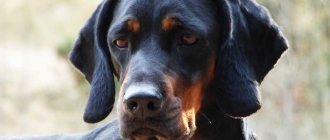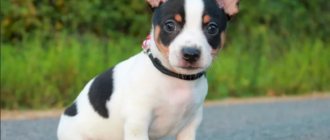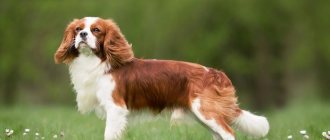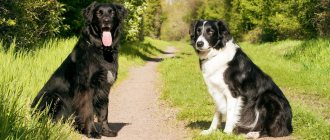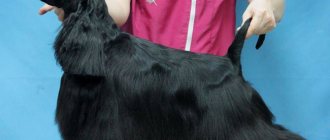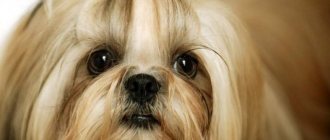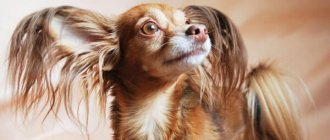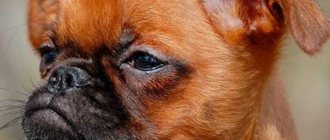The Finnish hound is a universal hunting dog, but it can only work in the warm seasons of the year. The versatility lies in the fact that dogs are fearless and, with appropriate training, can chase any animal. Another feature is the melody of the dog’s voice; thanks to its tone, the four-legged dogs are able to give special signals during the rut.
Note! The breed is usually called the Tricolored Finnish Hound, but in its homeland the name Suomenajokoira is more popular.
History of the Finnish Hound breed
There are no exact facts about the origin of the Finnish hound. The first mention dates back to 1850. It is believed that this dog combines the best qualities of hound breeds, and possibly the English Foxhound. But it is reliably known that the jeweler Tammelin, who lived in the Finnish city of Pori, began the selection of this breed in 1870, ensuring that only the best working qualities were preserved in the offspring (which, however, he succeeded very well). Appearance was not given much attention, but in 1932 the Finnish Kennel Club established a tricolor color. The International Canine Association recognized the breed in 1954.
Today the breed is not so numerous, since hunting is not an important human activity. But these dogs excel in sports competitions, so they still have fans.
65 years have passed since the Finnish Hound was recognized by the FCI
In Russia it is difficult to find a Finnish hound, but in Norway, Denmark, and Sweden they are preferred over other hound breeds.
In the homeland of the breed, its name sounds like Suomenajokoira.
How to choose a nickname?
Representatives of hound dog breeds are characterized by tirelessness, swiftness, vocality, loyalty, sensitivity and responsibility. The animal's nickname should be unusual, sonorous, and most importantly, the dog should respond to it. When choosing a name, you should take into account the characteristic features of the dog, for example, Thunder can be called a hound with a loud voice, but Wind is one that is difficult to keep up with.
It is strictly not recommended to give the names of dead animals, as this may affect the fate of the dog. If the hound already had a name, then you should not give it a new name. If a dog responds to its name, then it should be rewarded. A representative of this breed can be called Agat, Aira, Astik, Bayra, Burya, Vast, Glan, Gella, Drag, Dune.
Description of the breed
The current breed standard was published on July 17, 1997. According to the FCI classification, the Finnish Hound belongs to group 6 (“Hounds, Bloodhounds and Related Breeds”), section 1.2 (“Medium-sized Hounds”). When evaluating a dog, a test of working qualities is mandatory.
External qualities of the Finnish hound
The standard describes the Finnish hound as a strong, tri-colored dog, rather tall-legged, with an elongated body. The chest of the representatives is very wide, which is due to the loud barking during the rutting season (a lot of air is required, the lungs expand and form a wide chest).
The standard contains an image of the ideal representative of the breed
Gender differences are clearly expressed: males are taller and more powerful than females.
Basic appearance parameters:
- The skull is wide, domed. The groove between the eyes is barely noticeable; the brow ridges and the occipital protuberance are clearly defined. The stop is not sharp, but noticeable.
- The nose is black with large mobile nostrils.
- The jaw is strong and has a scissor bite.
- The eyes are medium in size, almost oval in shape, dark brown in color. The expression is attentive, calm.
- The ears are hanging, high-set, flat, and when pulled forward they extend beyond half the muzzle.
- The body is muscular, the stomach is slightly tucked.
- The tail is set low, slightly curved, reaching the hocks. Thick at the base, tapering towards the end. Usually carried down, but when running it can rise without crossing the topline.
- Limbs straight and parallel. Paws are oval, with narrow toes gathered. Claws and pads are preferably black.
- The movements are light, sweeping, the limbs move parallel to each other.
- The coat is medium length, straight, lying close to the body. The undercoat is short and dense.
- The color is tricolor: dark red on the head, limbs, shoulders, lower chest;
- black saddle on the back;
- white on head, neck, throat, front of chest, lower limbs, end of tail.
- males - from 55 cm to 61 cm (ideal height - from 57 to 59 cm);
Character and temperament
According to the standard, the Finnish Hound is a calm, energetic and friendly dog that never shows aggression. She definitely needs human company. Deprived of it, the dog may become indifferent to its surroundings or, conversely, nervous. Usually the Finnish hound is used for its intended purpose and is not kept at home, but those who have acquired this pet as a companion note its calm behavior and friendly attitude towards all family members.
The main purpose of the dog is to hunt, mainly foxes and hares, but this breed is called universal. She could drive wolves, deer, lynxes (which she did in ancient times, but now these types of hunting are prohibited). The dog follows the scent on its own and barks loudly, guiding the person. It can work even in difficult conditions, but only in the warm season. During work, he shows amazing endurance and activity.
It is not recommended to use the Finnish hound as a watchdog. Her innate friendliness will not allow her to perform this function. It is necessary to carry out early socialization of the pet so that it is not afraid of strangers and relatives.
Small domestic animals will always be under threat if a family gets such a pet. This applies even to those cats with whom the puppy grew up. Hunting instincts turn out to be stronger than even many years of proximity.
Disadvantages and defects of the breed
All deviations from standard characteristics are deficiencies, but they are assessed in accordance with their severity and impact on the health and performance of the dog.
So, the disadvantages include:
- too light or heavy type of build;
- triangular head;
- folds on the skin;
- narrow or short muzzle;
- direct bite or slight underbite;
- short and soft wool;
- mottled color or blurred color boundaries;
- height 1 cm higher or lower than specified in the standard;
- Behavior with other dogs is cowardly or defiantly pugnacious.
Vices that become grounds for disqualification include:
- aggressiveness or cowardice;
- depigmentation of the nose;
- obvious overshot or undershot;
- curled tail;
- height exceeding or lower than specified in the standard by more than 1 cm.
Video: Finnish hound breed
Peculiarities
The hound dog is a born hunter with an excellent scent and hunting instinct. This breed has been considered widespread since medieval times. The animal has earned its popularity due to its quick reactions and assistance to humans in tracking prey.
Hound dogs have the following distinctive appearance characteristics:
- Ears of different lengths that hang freely. The ends of the shells are directed towards the bottom.
- The bridge of the nose is straight type.
- The nose is colored black.
- The lips are tightly attached to the jaws.
- The large skull has a joint at the junction with the neck.
- The back is straight.
- The chest is voluminous.
- The paws are characterized by muscularity and strength.
- The coat is smooth and short. The fur color can be piebald, saddleback, wolf, merle or red-yellow.
Animals of this breed are not tall. Their height is slightly above average, their body length can reach 0.65 m. The body has clear outlines, and in some dogs the ribs may protrude.
Both males and females have long, powerful paws. The animal's tail is not short.
The muzzle of the “vyzhlovka” is elongated, the neck is beautiful. Dogs' eyes are set straight, their gaze is characterized by clarity and liveliness. Other signs that are characteristic of all hound dogs are high speed of movement, endurance, perseverance, and a loud voice.
Training rules
The Finnish hound must be trained to interact with the owner both during the hunt and outside of it. It will be easiest to train a puppy from working parents, but even if this is not the case, you should not despair. Training should begin as early as possible and it is better if you have the help of a specialist.
Finnish hound needs training in hunting skills
The main things you should teach your puppy:
- Come to the owner's call immediately upon hearing the nickname. This is achieved by training during eating, when the puppy is allowed to eat only on the condition that he appears immediately after the call. When the reaction to the name is worked out, the puppy is taught to react in the same way to the sound of the horn.
- Find the owner. To do this, the puppy must navigate by smell and trail both on the plain and in the forest zone. The skill is practiced at special training grounds.
- Keep track without getting distracted or switching to other smells.
- Give a voice when detecting tracks and prey, as well as during the entire period of rutting after it. Silent individuals among hounds are removed from breeding.
Hunting
The Finnish Hound is famous for its keen sense of smell and eagerness to work. Hunters respect the breed for a number of skills, one of which is its ability to locate game very quickly. It is known that the Finnish Hound can pursue prey for a long time and tirelessly in hot weather conditions. It is known that the higher the air temperature, the faster the animal becomes exhausted. During the pursuit, representatives of the breed emit a very melodic and loud bark, which allows them to track the movement of the animal.
This is interesting! There are known cases when Finnish hounds chased prey for three days.
With timely training, puppies at 6–7 months of age are ready to go out into the field and learn from adult dogs. Such young four-legged animals are allowed to work because in the process of hunting they learn better and more easily. Modern hunters use Finnish hounds to hunt hare, fox and even wild boar.
Care and maintenance
Any hound needs to be active every day. This is not only her job, but also a necessity, without which the hound develops stress. If the dog is not used for hunting, it should engage in sports exercises or simply receive intense exercise by running a lot (for example, accompanying the owner on a bike ride).
The Finnish Hound needs intense daily exercise.
The most suitable conditions for keeping are a private house with a large yard. It is allowed to keep a Finnish hound in an apartment, but walks should be long, at least 2 times a day for 2 hours, and preferably active.
Also, when starting a Finnish hound, the owner must take into account its “talkativeness”. This dog is very vocal, so if you keep it in an apartment, you cannot avoid complaints from neighbors.
Finnish hounds are sociable, so it is recommended to walk them with other dogs if possible. But you should not let him off the leash in places not equipped for walking - the hunting instincts are too strong, the dog can run far, get lost or get hit by a car.
Otherwise, caring for the Finnish hound is simple:
- Once a week, the pet's fur is cleaned with a rubber mitten to remove dead hair, dust, and dirt particles. During shedding, it is better to use a stiff brush.
- Bathing is rare, 2–3 times a year. In other cases, contaminated wool is simply wiped with a damp cloth.
- Eyes are wiped daily.
- There is no need to trim the nails of working dogs; they are worn down while running over rough terrain.
- The ears are checked and cleaned 2-3 times a week, since the dog is active and the pinnae cover the ear canal. This breed often develops ear infections.
- After the hunt, the pet is carefully examined for scratches and other damage. Particular attention is paid to the paw pads.
Feeding your pet
Finnish hounds always have a good appetite. At the same time, they are ready to eat everything that is edible. Great news for owners, on the one hand. On the other hand, this is a direct path to excess weight in a pet if it does not receive sufficiently intense exercise. Therefore, the owner should pay special attention to feeding. It has two ways:
- natural diet;
- ready-made dry and wet food.
Based on the characteristics of the Finnish hound, the second option is preferable. When choosing industrial food, the owner can accurately dose the portions, following the recommendations on the packaging. It is only recommended to increase them a little if the dog is actively working. Since the hound needs complete protein, the food should be at least premium.
When choosing ready-made food, preference should be given to special products for active individuals:
- Royal Canin HE Club;
- Chicopee Pro Nature Line Active;
- Acana Heritage Sport & Agility;
Acana Heritage Light & Fit consists of free-range chicken, turkey, nest-laid eggs and wild-caught flounder
- Belcando Adult Active.
In the case of a natural diet, the menu must be developed together with a veterinarian. Portions should be nutritious and balanced in protein, fat and carbohydrates. Also in this case, it is necessary to introduce vitamin and mineral supplements into the diet.
Character of the Hungarian Vizsla
The Hungarian Pointer is one of the few hunting breeds that are suitable for novice dog owners. These pets are rightfully considered universal, and all thanks to their insightful mind, devotion, activity, friendliness and sociability. Balanced dogs can make excellent companions not only for hunting, but also for everyday life.
Hungarian Vizslas truly enjoy communicating with family members, but they see only one person as the owner. With this honorary “title” comes a new responsibility – close contact with your pet. Short-haired cops are jokingly called “Velcro” because they accompany their owner even within the apartment. Wherever you go - to the kitchen, to the bedroom or to the bathroom - the animal will not leave this attack unnoticed. A locked room is an unreliable obstacle: the dog would rather curl up in a ball and wait for your return than go off about its business.
The Hungarian Vizsla is a breed that requires unconditional love, patience and constant attention from the owner. If you are away from home for a long time, it is worth thinking about other dogs that do not tolerate separation from their owner so hard. It could be a Shar Pei, Dachshund or Shih Tzu. It is necessary to take into account: these breeds also need regular company, so you should not perceive the animal only as a funny “accessory”.
The ideal owner for a Hungarian pointer is a sporty and cheerful person, and even better, a hunter. Dogs do not like to sit idle: for them, an active walk is more attractive than a long sleep on the sofa. In addition, developed intelligence literally “obliges” animals to resort to daily mental and physical stress. The Hungarian Vizsla will not approve of walking only to relieve itself. Lack of attention on the part of the owner will result in regular mischief, among which a chewed sofa will seem like a trifle in life.
This breed is not suitable for people who need a fierce guard dog. The most a stranger can expect is a loud bark and a warning growl. A Vizsla will not rush into an attack without a good reason, and even more so if the owner is not in danger. Hungarian cops prefer defensive tactics. A special training course will help improve your dog’s guarding qualities - always performed by a professional dog handler!
Since Hungarian Vizslas have a playful disposition, they make excellent company for children. Representatives of the breed are patient and gentle, ready to actively participate in the proposed games and at the same time not show the slightest hint of fatigue. However, you should not leave your child alone with the dog: due to its large size, strength and activity, it can inadvertently push its little friend and thereby cause injury to him. Otherwise, Vizslas are understanding and sensitive pets that can easily cope with the role of “nanny” while you relax after a working day.
It will not be difficult for Hungarian cops to make friends with their relatives. Even dogs of the same sex do not consider each other rivals. Getting to know a cat will require your participation, and you should completely refrain from contact with small pets. Vizslas are hunting dogs, so they can be aggressive towards potential prey. For the same reason, you should not let the cop off the leash: animals tend to react violently to the presence of strange cats and even pigeons.
The lively temperament of the Hungarian Vizsla is noticeable when walking, and especially outside the city, in a field or on the river bank. The dogs seem to throw off invisible shackles and begin to hunt. No matter how far a cop runs in search of prey, it will never lose sight of its owner. Representatives of this breed work “for the public”, wanting to hear praise and approval. Vizslas are especially delighted by the opportunity to swim. Don’t interfere with your pet’s instincts - and he will thank you with wet “kisses” and a calm evening after a busy day!
Breed diseases
The average lifespan of a Finnish hound is 13–15 years. In general, these are strong and healthy dogs. Of the genetically transmitted diseases, Finnish hounds are characterized by:
- dysplasia of the elbow and hip joint - abnormal development of the articular head, which first leads to lameness and then immobility of the animal, is detected by genetic tests;
- Cerebellar ataxia is a dysfunction of this part of the brain, which leads to disproportionality in the animal’s movements; if the symptoms are not noticed in time, the dog ultimately dies;
- tendency to demodicosis - damage by subcutaneous mites.
Also, dogs of this breed often experience excess weight due to insufficient physical activity, which subsequently leads to diseases of the joints and cardiovascular system.
Health
The average life expectancy of the Finnish Hound is 13–15 years, which is a very good indicator for a working dog. Purebred dogs have good health and virtually no hereditary diseases. Purebred means that Finnish Hound puppies were obtained from producers with approved pedigrees. It is equally important that puppies undergo an initial medical examination to determine whether they are susceptible to hip dysplasia. By the time of sale, puppies must be vaccinated with a comprehensive vaccine.
The Finnish Hound has only one weak point - its ears. Since the dog loves to run and work, ears that fit tightly to the head are a negative factor. Dogs do not sweat, but during exercise the mucous membranes work more actively. In the dog’s ears after exercise, humidity and temperature increase, which creates very favorable conditions for the development of bacterial and infectious diseases. All Finnish hounds are prone to otitis of varying severity. The owner’s task is to monitor the condition of the ears, since mild external otitis can take a chronic or acute form.
Choosing a puppy
In Russia, the Finnish hound is a rare breed, so if you want to get such a pet, you should establish contacts with foreign nurseries in Finland, Denmark, and Sweden. Considering the difficulties of transportation, a puppy will not cost less than 20 thousand rubles. And the offspring of working parents with an ideal pedigree are estimated at 30 thousand rubles.
Finnish hound puppies should be looked for in foreign nurseries
When choosing a puppy, you should focus on both external signs of health and the presence of a pedigree (for kids, this is a puppy card). The puppy should be friendly and inquisitive, and not shy away from people. It would be good to see his parents, they also should not be timid or aggressive. It is important that there are no “silent people” in the family.
It is better to choose a puppy at the age of 5 months, but rarely do any breeders keep babies up to that age. Then you can trust the eye of the owner, who has already noticed which of the litter has the best hunting qualities.
Feeding
For the health, development and well-being of hound dogs, a balanced and high-quality diet is required. An adult is given food twice a day. Those representatives who lead an active lifestyle and participate in hunting should have a complete diet. These dogs need a lot of protein. As an option, you can use dry food, which contains everything your pet needs.
Fish should be served boiled or stewed. Dairy products are given in the form of cottage cheese, milk, kefir, and cheese. Also, don’t forget about cereals and raw bones. The animal's blood is considered beneficial for the hunting breed.
Products that are prohibited for hound dogs include additives, spices, sugar, cocoa, mustard, vinegar, fatty meats, as well as food from the human table.
